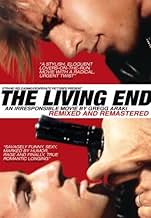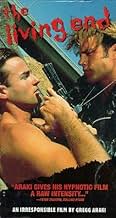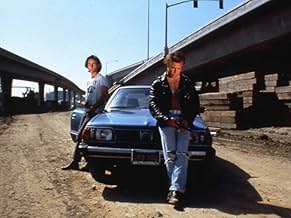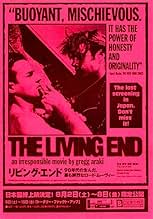IMDb रेटिंग
6.6/10
4.2 हज़ार
आपकी रेटिंग
अपनी भाषा में प्लॉट जोड़ेंLuke is a gay hustler. Jon is a movie critic. Both are HIV positive. They go on a hedonistic, dangerous journey, their motto "Fuck the world".Luke is a gay hustler. Jon is a movie critic. Both are HIV positive. They go on a hedonistic, dangerous journey, their motto "Fuck the world".Luke is a gay hustler. Jon is a movie critic. Both are HIV positive. They go on a hedonistic, dangerous journey, their motto "Fuck the world".
- पुरस्कार
- कुल 1 नामांकन
Brett Vail
- Ken
- (as Bretton Vail)
Chris Mabli
- Melrose NeoNazi
- (as Christopher Mabli)
Peter Grame
- Gus
- (as Peter Gramé)
फ़ीचर्ड समीक्षाएं
10preppy-3
Two HIV+ men go on a road trip. Basically that's about it. It's not as depressing as it sounds. There's lots of humor in the movie but no pulling back on the anger they feel.
The camera-work is shaky, the sound goes from audible to inaudible more than once and there really is no plot. Also, must we have the tired old stereotypes of two lesbians being psychopaths? But the dialogue contains more truth than any Hollywood movie I've seen. For instance, at one point, one of the guys goes "Let's go to Washington and inject our blood in the President. Want to bet they'll find a cure in 30 seconds?" Sadly, I believe they would. This was WAY ahead of its time in 1992. It was angry, in your face and catch a look at a little message after the closing credits,.
Grim, funny, powerful with a sad (but truthful) ending. Also Mike Dytri is one of the most beautiful, hunky men I've ever seen.
A must-see for gay men.
The camera-work is shaky, the sound goes from audible to inaudible more than once and there really is no plot. Also, must we have the tired old stereotypes of two lesbians being psychopaths? But the dialogue contains more truth than any Hollywood movie I've seen. For instance, at one point, one of the guys goes "Let's go to Washington and inject our blood in the President. Want to bet they'll find a cure in 30 seconds?" Sadly, I believe they would. This was WAY ahead of its time in 1992. It was angry, in your face and catch a look at a little message after the closing credits,.
Grim, funny, powerful with a sad (but truthful) ending. Also Mike Dytri is one of the most beautiful, hunky men I've ever seen.
A must-see for gay men.
My first impression going in to see "Brokeback Mountain" when that one came out, was; "How boringly common gay love seem to be". And i thought of it being boringly common in a cinematic sense. Only rule broken in that movie was to make it possible for a large audience to have empathy with it characters without hiding the gayness of them. It worked. I salute that. And i still think that was the performance that earned Ledger his Oscar.
But Arakki does not stay within content when making his movies great (when they are). His style is widely overlooked by his "controversial" content. Even though the two are matched as should be in good art craft.
Let me just give you one example to look for. One scene, in the beginning of the movie, we see the character of Luke, who's been hustling another man, back at that mans place. Suddenly the john's wife or girlfriend appears and the acting style changes to that of badly made porn. But not only the style of acting, also the cutting. The woman and Luke never appear in the same frame and the shots of him reacting to her, could have been taken weeks apart (a common use in porn to make models appear in the same scene, although they were never on set). The woman is acting so badly, that it can only be a parody of the clichés of porn too, since, Arraki surely knows how to get good actors and know how to direct them.
Lots of other good stuff could be commented on, but let me just get back to my pronouncing it the best gay LOVE story told on screen; Even thought the character of Luke can be seen as only a projection of Jon's diagnosis as HIV positive (His way of coping with it as Scottie has to invent Madelaine in "Vertigo" facing death).... it still is a love story, sick as it may seem. And a hell of a lot closer to fulfilling what we look for in love stories, than the ones with either happy or weepy ends. This one has both and rings truer.
But Arakki does not stay within content when making his movies great (when they are). His style is widely overlooked by his "controversial" content. Even though the two are matched as should be in good art craft.
Let me just give you one example to look for. One scene, in the beginning of the movie, we see the character of Luke, who's been hustling another man, back at that mans place. Suddenly the john's wife or girlfriend appears and the acting style changes to that of badly made porn. But not only the style of acting, also the cutting. The woman and Luke never appear in the same frame and the shots of him reacting to her, could have been taken weeks apart (a common use in porn to make models appear in the same scene, although they were never on set). The woman is acting so badly, that it can only be a parody of the clichés of porn too, since, Arraki surely knows how to get good actors and know how to direct them.
Lots of other good stuff could be commented on, but let me just get back to my pronouncing it the best gay LOVE story told on screen; Even thought the character of Luke can be seen as only a projection of Jon's diagnosis as HIV positive (His way of coping with it as Scottie has to invent Madelaine in "Vertigo" facing death).... it still is a love story, sick as it may seem. And a hell of a lot closer to fulfilling what we look for in love stories, than the ones with either happy or weepy ends. This one has both and rings truer.
Let's see: Bad lighting. Ugly cinematography. Barely audible sound. Profanity laced dialogue. Amateurish performances. Protagonists whose bad behavior is supposed to represent TRUTH. Cameos by Paul Bartel and Mary Woronov. Yep, we are in the world of indie filmmaking, where the mere fact that a semi-coherent film even gets completed on a budget of a buck-ninety-two is considered an artistic achievement. THE LIVING END is a cult film and considered something a landmark of gay cinema to boot. Two guys, who are HIV+ positive, act out violently to protest ... well, to protest just about anything and everything immediately available. The "angry young gay man" syndrome is in play: We're here, we're queer, we're going to be annoying. It was pretty radical stuff for the time; pre-Ellen, pre-Will-&-Grace, pre-Queer Eye. Now, in the era of legalized gay marriage, this seems rather quaintly naive: more Hope and Crosby than Butch and Sundance, let alone Thelma and Louise.
The problem is that, divorced from its historical context, THE LIVING END is just painfully mediocre at best and just plain bad much of the time. Even overlooking the fifth rate production values, you still have a contrived story, badly written, poorly directed and awkwardly acted. The tale involves Jon, who, on the day he learns he is HIV+, encounters Luke, a leather-jacketed stud on the run from freshly killing a trio of gay bashers. Jon is a nerd (he writes film reviews); Luke is a thug (he apparently has also killed a cop); and they head out on the road to who-knows-where. Luke claims he has fallen madly in love with Jon, while Jon seems gaga over Luke apparently because Luke looks hot in a leather jacket (and even hotter minus the jacket). Ultimately their road trip goes nowhere and little is done that couldn't have just as easily been done in Jon's cramped little apartment. Toss in a bothersome side story involving Jon's mother hen (read fag hag) best friend whose sex life goes south as she worries about Jon being AWOL, and the already threadbare narrative is revealed to be even flimsier.
But to give it credit, THE LIVING END was something different in its time. It deals with gay rage, AIDS and gives us anti-heroes who are hardly role models, but at least aren't negative stereotypes from the straight point of view. The film is subtitled "An Irresponsible Film by Gregg Araki," and several of the scenes are provocative. Certainly director Araki is not interested in political correctness, particularly in the way he attempts to link sex and violence as a common impulse. Indeed, the film's most powerful moment comes at the end as it ties rape and suicide into one graphic image. The final scenes are jolting, especially considering the banality of the rest of the film.
I want to be generous to this film because it is sincere and it is important within the subgenre of gay cinema. But it just isn't very good; there just isn't any nicer way to say it. THE LIVING END is a dead end.
The problem is that, divorced from its historical context, THE LIVING END is just painfully mediocre at best and just plain bad much of the time. Even overlooking the fifth rate production values, you still have a contrived story, badly written, poorly directed and awkwardly acted. The tale involves Jon, who, on the day he learns he is HIV+, encounters Luke, a leather-jacketed stud on the run from freshly killing a trio of gay bashers. Jon is a nerd (he writes film reviews); Luke is a thug (he apparently has also killed a cop); and they head out on the road to who-knows-where. Luke claims he has fallen madly in love with Jon, while Jon seems gaga over Luke apparently because Luke looks hot in a leather jacket (and even hotter minus the jacket). Ultimately their road trip goes nowhere and little is done that couldn't have just as easily been done in Jon's cramped little apartment. Toss in a bothersome side story involving Jon's mother hen (read fag hag) best friend whose sex life goes south as she worries about Jon being AWOL, and the already threadbare narrative is revealed to be even flimsier.
But to give it credit, THE LIVING END was something different in its time. It deals with gay rage, AIDS and gives us anti-heroes who are hardly role models, but at least aren't negative stereotypes from the straight point of view. The film is subtitled "An Irresponsible Film by Gregg Araki," and several of the scenes are provocative. Certainly director Araki is not interested in political correctness, particularly in the way he attempts to link sex and violence as a common impulse. Indeed, the film's most powerful moment comes at the end as it ties rape and suicide into one graphic image. The final scenes are jolting, especially considering the banality of the rest of the film.
I want to be generous to this film because it is sincere and it is important within the subgenre of gay cinema. But it just isn't very good; there just isn't any nicer way to say it. THE LIVING END is a dead end.
Anyone else remember those robotic fish that you'd prod and they wagged their tails? We had one that also sang Bobby Darin's "Mack the Knife"! Here, one features occasionally, but quite amusingly, in this quite provocative drama that follows a road trip taken by "Luke" (Mike Dytri) and "Jon" (Crag Gilmore). The former guy is a gay hooker who's got by on the streets using his looks and his wits whilst contracting HIV along the way. The latter man is a journalist who has managed to arrive at the same fate - though not as a result of the same s(t)eamy existence. With nothing much left to lose, the unlikely pairing embark on a fairly hedonistic journey that pitches their two completely different personalities into a series of scenarios that ultimately, well you can guess what ends up happening. It doesn't pull it's punches this. It is gritty and sleazy and honest and illustrates well just how human beings react when faced with certainty - even if it's timeline isn't so set in stone. It's a love story, an hate story - and juggles loads of attitudinal and judgemental horrors as the two men meet homophobia and violence as they begin to rely more and more on each other (whilst simultaneously winding each other up fairly spectacularly). There's a bit of sex - nothing very graphic, and loads of ripe language - but nothing here appears gratuitous. It's a plausible road trip that Greg Araki has constructed to make us think, squirm, smile and well, endure too. It won't be for everyone, but it does remind us of how, just 20-odd years ago, AIDS was still killing people and there is a definite and engaging chemistry between the two actors charged with delivering this story of a messy and frequently anachronistic existence.
A film I enjoyed far more than I 'should' have, given how many individual moments I disliked.
Full of somewhat forced, wanna-be John Waters style humor that is sometimes funny, but often just over-arch and clunky. And some of the acting is weak, the rest only pretty good.
Yet underneath it all there is something moving, honest and raw in its punky rage at the world from an HIV positive point of view.
Sort of a gay, surrealist Thelma and Louise made on a shoestring. For all the moments I rolled my eyes, I feel like it will stick with me over time.
Full of somewhat forced, wanna-be John Waters style humor that is sometimes funny, but often just over-arch and clunky. And some of the acting is weak, the rest only pretty good.
Yet underneath it all there is something moving, honest and raw in its punky rage at the world from an HIV positive point of view.
Sort of a gay, surrealist Thelma and Louise made on a shoestring. For all the moments I rolled my eyes, I feel like it will stick with me over time.
क्या आपको पता है
- ट्रिवियाThe end credits finish with the following words: "dedicated to craig lee (1954-1991) and the hundreds of thousands who've died and the hundreds of thousands more who will die because of a big white house full of republican fuckheads".
- कनेक्शनFeatured in The Celluloid Closet (1995)
- साउंडट्रैकWhere The Pavement Ends
Performed by Braindead Sound Machine
टॉप पसंद
रेटिंग देने के लिए साइन-इन करें और वैयक्तिकृत सुझावों के लिए वॉचलिस्ट करें
- How long is The Living End?Alexa द्वारा संचालित
विवरण
बॉक्स ऑफ़िस
- बजट
- $22,769(अनुमानित)
- US और कनाडा में सकल
- $6,92,585
- US और कनाडा में पहले सप्ताह में कुल कमाई
- $43,715
- 16 अग॰ 1992
- दुनिया भर में सकल
- $6,92,585
इस पेज में योगदान दें
किसी बदलाव का सुझाव दें या अनुपलब्ध कॉन्टेंट जोड़ें


























